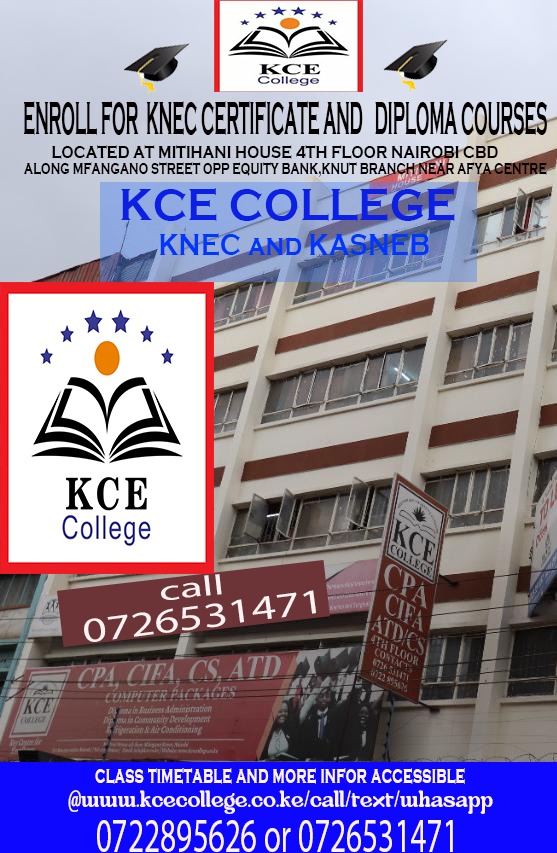Data Communication and networking July 2016 Past Examination Question Paper – KNEC
This Past Paper examination was examined by the Kenya National Examination Council (KNEC) and it applies to the following courses:
-
Diploma in Information Communication Technology – Module III
Note: To easily navigate through the KNEC Past Examination Paper Pdf below, Mobile phone users are advised to use Mozilla or Chrome browsers
THE KENYA NATIONAL EXAMINATIONS COUNCIL
DIPLOMA IN INFORMATION COMMUNICATION TECHNOLOGY
MODULE III
DATA COMMUNICATION AND NETWORKING
July 2016
Time: 3 hours
INSTRUCTIONS TO THE CANDIDATES
Answer any FIVE of the following RIGHT questions in the answer booklet provided.
ALL questions carry equal marks.
Candidates should answer the questions in English.
1. (a) (i) List three criteria that could be used to classify data communication networks. (3 marks)
(ii) Distinguish between a powered-over-Ethernet (PoE) and a non-PoE switch. (4 marks)
(b) (i) Outline three factors that should be considered when selecting a switch, other than cost. (3 marks)
(ii) Bottom-up troubleshooting approach could be used by network administrators to establish a network fault. Outline four disadvantages they are likely to realize while using this approach. (4 marks)
c) Implementation of any network design should follow several design principles. Describe three principles that should be adhered to. (6 marks)
2. (a) (i) Outline two categories of wireless networks. (2 marks)
(ii) Explain the term encapsulation as applied to transport protocols. (2 marks)
(b) (i) Distinguish between blogs and portals as used in the Internet. (4 marks)
(ii) Figure 1 shows a TCP/IP termination process. Identify appropriate descriptor for each process labelled (i), (ii), (iii) and (ix). (4 marks)

Figure 1
(c) CFG polytechnic intends to install a wireless network that Uses radio frequency for transmission. Outline four characteristics o1 the signal in the network. (4 marks)
(d) Farasi College has introduced Internet services to its students. Explain two challenges that the college is likely to experience. (4 marks)
3. Explain each of the following terms as used in the Internet:
(i) cookies; (2 marks)
(ii) history. (2 marks)
b) Network operating systems provide critical functions in data communication systems. Outline four typical functions that are likely to be realized. (4 marks)
(c) Logical security measures are normally recommended approaches of preventing network insecurity incidences. Explain two such measures. (4 marks)
(d) (i) Explain this two sub layers of the data link layer used by LAN. (4 marks)
(ii) Every network topology requires careful considerations before installation. Outline four factors that should consider before the installation, other than cost. (4 marks)
4. (a) Explain three desirable characteristics of a web browser. (6 marks)
(b) Network reliability is a one of the design metrics for corporate networks. Explain two measures that could be adopted to enhance network reliability. (4 marks)
(c) Network intrusions are increasingly affecting business operations. Explain two wrong practices that could intensify these intrusions. (4 marks)
(d) Maria intends to replace static routing protocol in her company’s network. Explain three disadvantages of the static routing protocols that could influence her decision. (6 marks)
5. (a) (i) Outline two advantages of using frame relay protocol. (2 marks)
(ii) Distinguish between network and host addresses as applied in IP addressing. (4 marks)
b) Shielded twisted-pair (STP) cables are commonly used in private nehvor1‹s. Explain two benefits of STP cables that could be influencing this trend. (4 marks)
(c) With the aid of a diagram, describe the structure of a coaxial cable. (4 mans)
(d) Data transmission uses several multiplexing techniques. Describe three multiplexing techniques that are likely to be used (6 mans)
6. (a) Describe two types of connectors used with fiber optical cables. (4 marks)
(b) (i) Outline two strengths of TCP/IP protocol in data communication. (2 marks)
(ii) Paul was required to identify ISDN channels in a job interview. Explain two channels that he could have mentioned. (4 marks)
c) Bring your own device (BYOD) poses some risks to software cooperate networks. Explain two potential risks that are likely to be experienced. (4 marks)
(d) Explain three circumstances under which Point-to-Point Protocol (PPP) could be used on a corporate network. (6 marks)
7. (a) Distinguish between Data Terminal Equipment and Data Communication Equipment .
(b) Explain three parts/elements of a data link layer frame. (6 marks)
c) UDP is a simple protocol that provides the basic transport layer functions. Explain three requirements for its application in a network. (6 marks)
(d) Tom was Required to install a communication software in his company’s network:
Explain two methods of installation that he could use. (4 marks)
8. a) i) Outline four minimum documentation details for troubleshooting a network. (4 marks)
ii) Figure 2 shows typical tool bar of a browser program. Outline the function for each of the internet zones labelled (i), (ii), (iii) and (iv). (4 marks)

Figure 2
(b) i) Define the term blind spot as applied in data transmission. (2 marks)
ii) Charles intends to setup an email server for his company. Outline four requirements that she should consider in order to achieve her objective. (4 marks)
c) i) Outline two functions of the application layers of OSI model. (2 marks)
ii) Explain two circumstances that could necessitate use of the file transfer protocol in data communication. (4 marks)
